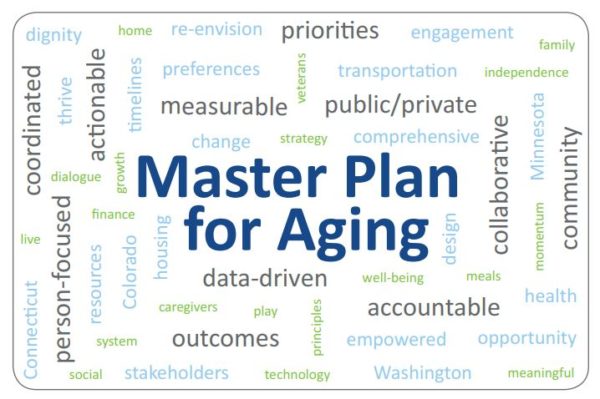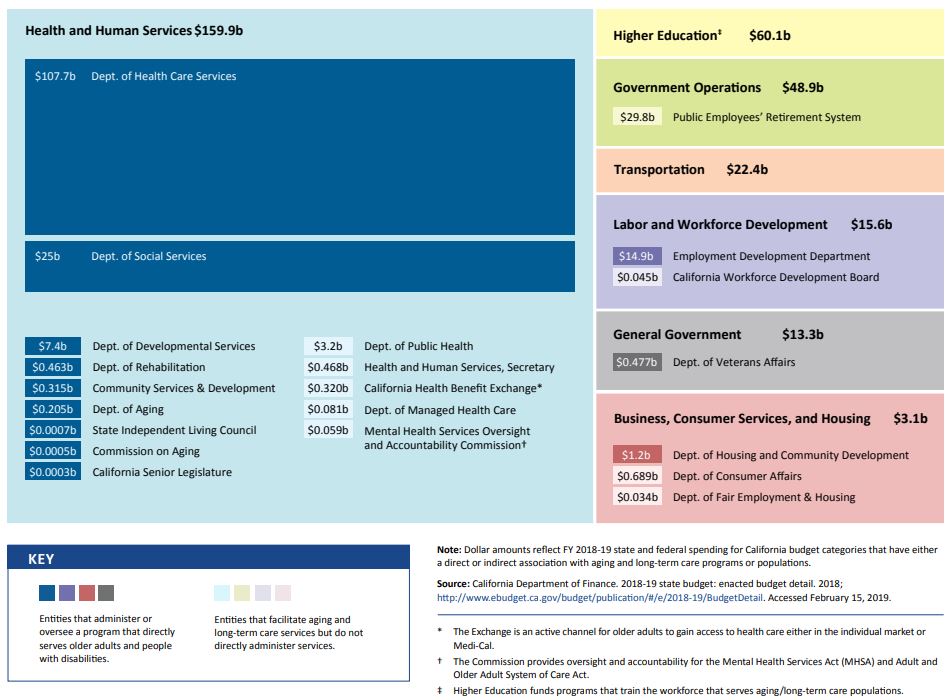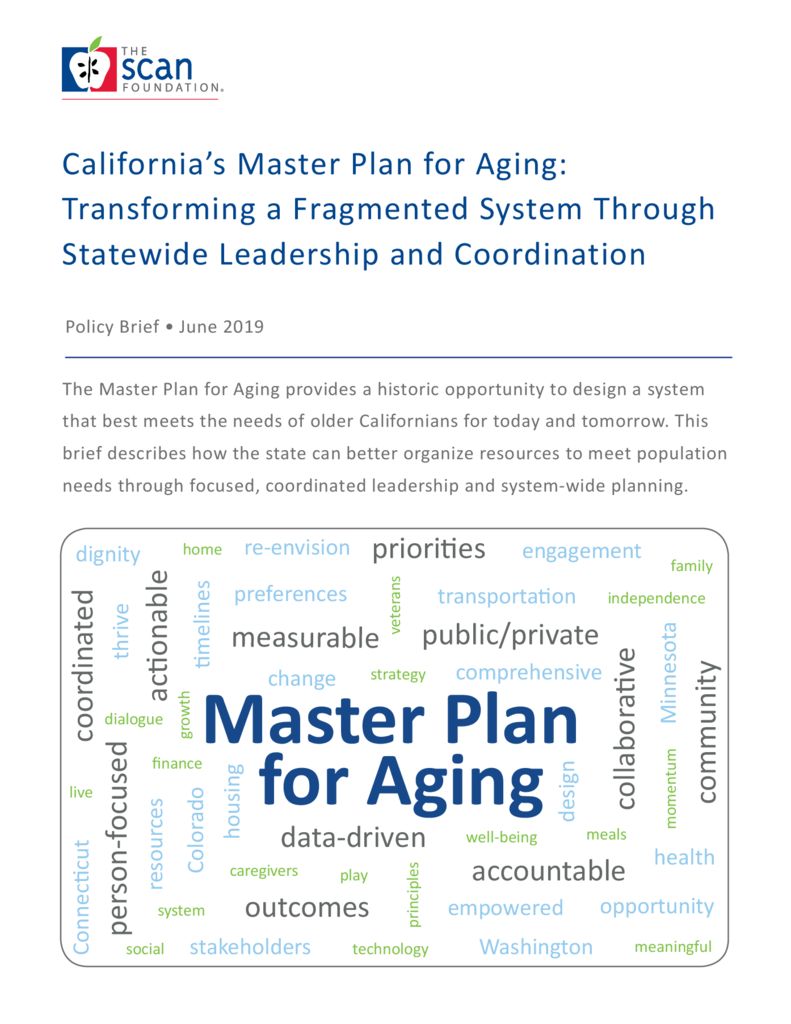California’s Master Plan for Aging: Transforming a Fragmented System Through Statewide Leadership and Coordination
summary
The Master Plan for Aging provides a historic opportunity to design a system that best meets the needs of older Californians of today and tomorrow. This brief describes how the state can better organize resources to meet population needs through focused, coordinated leadership and system-wide planning.
Date Updated: 06/11/2019All Californians should be empowered to age with dignity and independence — yet for many, this is an elusive dream. California’s system serving older adults and the families that stand by them is plagued with fragmentation, a crumbling infrastructure, and lack of sound financing options. This system has evolved in a piecemeal fashion, without intentional focus on how to best serve aging Californians through a coordinated approach that considers what matters most to the person. These challenges will only multiply as the state’s population ages and diversifies.

Governor Newsom took bold action on June 10, 2019 through an Executive Order, calling for the creation of a Master Plan for Aging (Master Plan).1 The governor heralded this Master Plan to “serve as a blueprint for state government, local government, private sector and philanthropy to…promote healthy aging and prepare the state for the coming demographic changes.”1 In his Executive Order, the governor directs the Secretary of the Health and Human Services Agency (Agency) to convene a state-level Workgroup on Aging that will advise on the development and issuance of a Master Plan. The Agency is also charged with convening a Master Plan for Aging Stakeholder Advisory Committee, consisting of a Research Subcommittee and a Long-Term Care Subcommittee, each of which will provide specific input. By March 1, 2020, the Long-Term Care Subcommittee must report to the governor on the growth and sustainability of the long-term care infrastructure, access to and quality of long-term care programs, system financing, and workforce capacity. The final Master Plan is due to the governor on October 1, 2020.
This Master Plan provides a historic opportunity to address system challenges in order to better meet the needs of aging Californians through a thoughtful, comprehensive strategy with specified accountability and achievable outcomes. This will only be possible by rethinking the following:
- The range and diversity of needs among aging Californians;
- The extent to which public spending and state staffing across agencies is effectively and efficiently meeting older Californians’ needs; and
- Leadership and coordination across state agencies.
In an effort to understand the extent to which state resources are meeting population needs, and how these resources could be effectively organized to streamline access in a person-centered manner, this brief illustrates the breadth of state agencies and their resources that either directly or indirectly serve older adults (per budget year 2018-19).2,3 This brief also describes how California can align state resources to meet population needs through focused, coordinated leadership and system-wide planning.
A Range of Issues, Involving Multiple Agencies and Sectors
For older Californians with chronic health conditions and daily living challenges who struggle to remain at home, it is often difficult to know what resources are needed and where to go for help. Frequently, family caregivers try to weave together a web of services, facing questions like “How do I get Mom to the doctor now that she can’t drive? How can she get up the stairs in a walker? Is there someone who can help her with cooking and cleaning at home?”
Today’s complex and fragmented service delivery system often sends older adults and families in multiple directions to a scattering of programs with varying eligibility and assessment processes, and with little sense of whether needs are being met. However, older adults and families do not view their needs in terms of eligibility standards for specific programs, and they do not care which entity administers which program. Instead, they seek a way to address their needs with timely connections to services responsive to those needs.
The challenges older adults and families face in accessing services are rooted in the piecemeal funding and administration of services at the state level. Historically, policy discussions on aging have been largely driven by health care and social service program issues. Yet, multiple state agencies have either a direct or indirect responsibility for implementing and paying for aging related services—as well as contracting for and overseeing programs in partnership with the private sector.
The graphic on page 4 references the various state agencies that play a role in Californians’ ability to age with dignity and independence (including Health and Human Services; Business, Consumer Services and Housing; Transportation; Veterans Affairs; Labor and Workforce Development; and Higher Education, among others). While a transparent display of funding for aging related programs and services is not available, the graphic portrays the range of state agencies that currently serve older Californians.
A Comprehensive, Coordinated Approach
Given this challenge, a successful Master Plan process should shift from discussions about a single issue, agency, or funding stream to a person-first orientation of system planning. Right now, despite multiple state agencies having touch points to aging issues, no one public sector leader is responsible for crafting and implementing a comprehensive approach to aging-related services. This void creates an enormous opportunity to build system coordination through the agencies listed in the graphic, as well as with the private sector that interfaces with the system.
California Agencies that Directly or Indirectly Serve Older Adults, 2018-19

At its best, the Master Plan should champion public resources to focus on the needs of older Californians and their families. Strong gubernatorial leadership – coupled with maximal engagement from state agencies – can lead the way to create a holistic, person-centered system for older adults of today and tomorrow.
Next Steps for Master Plan Success
The first step for a successful Master Plan is to establish a leader in the governor’s office who is responsible for overseeing plan development and implementation, working across the state agencies listed above. Naming a leader at this level can catalyze resources to establish a framework for spurring innovation and collaboration across state agencies, including private sector engagement. This approach will comprehensively address the emerging needs of older adults and their families—but from the person’s terms, not the system’s terms.
Second, and equally as important, is gathering and sharing information on the current needs of older Californians and their families to use in planning for tomorrow. This means obtaining a clear understanding of people’s needs, the extent to which the current system is meeting these needs, and where there are opportunities to address gaps. The process should begin with an assessment of all agency spending on services that impact older adults, with analysis of how existing resources and administrative authorities might be restructured to help older Californians thrive now and into the future.
With focused leadership and decisive state planning across agencies – and in collaboration with the private sector – these resources can be better organized and allocated according to the range of needs for older Californians and their family caregivers.
Download the publication for all visuals and complete references.
Continue Reading
The SCAN Foundation aims to identify models of care that bridge medical care and supportive service systems in an effort to meet people’s needs, values, and preferences. Care coordination is a central component of this vision, which ultimately leads to more person-centered care. This brief outlines The SCAN Foundation’s vision for care coordination in a person-centered, organized system.
This policy brief describes California’s results in the 2014 Long-Term Services and Supports State Scorecard, identifying areas for improvement as well as policy opportunities to transform and improve the state’s system of care.
To succeed in this era of health system transformation, plans and providers bearing risk – in an accountable care organization (ACO) for example – will need strategies for managing a broad array of care needs for high-risk beneficiaries across multiple settings of care. Download this fact sheet to learn more.


